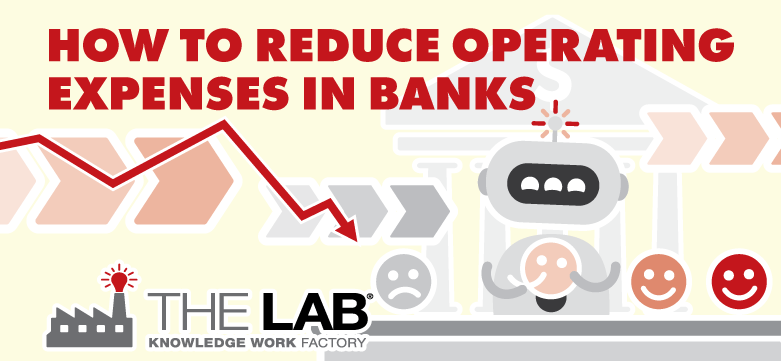How to Reduce Operating Expenses in Banks by Standardizing Common Processes
05/08/2017

It’s commonly believed that digital banking technology will automatically reduce expenses in front- and back-office operations. But it doesn’t.
In this article, we’re going to show how cost reduction in banking first requires that underlying processes are examined—and streamlined.
Banking operating expenses and cost cutting: A lesson from the past
You probably never heard of Charles Babbage. But he conceived the programmable computer…back in the 1830s. And the lessons from this story apply to cost reduction in banking, even today.
Babbage believed it was possible to apply the principles of industrialization, which were revolutionizing the factory floor, to knowledge work.
How did he do it? First, he divided complex mathematical tasks into simpler, repetitive sub-routines. Imagine a “knowledge work assembly line.” Next, he sought to automate these tasks.
He didn’t have computer chips or the Internet. He had the clockwork technologies available at the time. Still, using these, he conceived what he called a “Difference Engine.” It was a “knowledge work factory.” And it would eventually tip the scales at 15 tons.
Fast-forward more than a century. By the late 1960s, early efforts at cost cutting in the banking sector—ATMs—were taking shape. But progress toward digitization—toward Babbage’s dream of a “knowledge work assembly line”—stalled.
Sadly, you know where this story is headed. By 1994, Bill Gates referred to banks as “dinosaurs,” sliding fast down the slope toward extinction. More recently, fintech startups seek to hasten banks’ digital extinction. Everyone agrees: To cut costs, and to simply survive, banks must transform their digital initiatives.
Applying the lessons learned to reduce operating expenses in banks
Let’s not leave Charles Babbage in the pages of history. His work was brilliant. Even more important, it’s applicable today.
Babbage recognized that the heart of every project was a procedure, which could be broken down into smaller tasks. Each task could be analyzed and optimized. And success could be quantified.
That’s how to cut costs in banks. The first step is to apply the principles of industrialization—borrowed straight from the factory floor—to any digital transition. Before you digitize, analyze. Divide complex banking operations into simple and repetitive sub-routines. Then you’re in a position to automate, using today’s digital technology. You must “feed the machine” with the right input. Otherwise, you’re simply digitizing a bad system.
Cost cutting in the banking sector: Examples
How might an “industrial redesign” look—and how might it slash costs—in today’s bank or credit union? Consider these steps:
- Break down the intake operations for new loan applications, such as home equity, mortgage, and consumer loans.
- Create specialized assembly lines.
- Standardize the most common fixes, such as “missing information” or “unsigned document.”
- Automate the most standard activities.
- Reduce the root cause of problems upstream: Create clearer instructions and simpler forms.
It seems simple, but it’s radical. And the opportunities to reduce cost in banking can be simply staggering.
Cost cutting strategies for banks rooted in industrialization
Large-scale office automation technology first appeared in the 1920s. It featured mechanical filing systems, calculators, and punch-card tabulators.
It was new technology that promised a productivity and cost-saving revolution. Sound familiar?
Even then, automation required standardization. Industrialization.
But the executives of the era refused. So what happened? The tech vendors simply changed their sales pitch. The new technology, they claimed, would “gently force” office workers to change the way they worked. It would compel them to standardize, in order to use the new equipment.
It was a breakthrough for sales materials. But it was hardly a breakthrough when it came to productivity or cost reduction.
The “gently force” claim simply didn’t work. Reports from the time describe abandoned, under-used technology—and minimal gains in productivity. A century later, digital vendors still claim that their technology will “gently force” knowledge workers to adapt. Does this technology-driven approach work in today’s banks, especially in the absence of Babbage-like standardization and industrialization?
2022 update: We have updated and continue to update our banking operations improvement offering.
Find out how to strategically lower costs, increase operating leverage, improve customer experience, and automate what previously wasn’t automatable in your bank. Many of these findings and implementation results can be reviewed in the 3-part-series of “Big Rocks for Banks” below.


